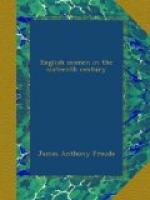LECTURE II
JOHN HAWKINS AND THE AFRICAN SLAVE TRADE
I begin this lecture with a petition addressed to Queen Elizabeth. Thomas Seely, a merchant of Bristol, hearing a Spaniard in a Spanish port utter foul and slanderous charges against the Queen’s character, knocked him down. To knock a man down for telling lies about Elizabeth might be a breach of the peace, but it had not yet been declared heresy. The Holy Office, however, seized Seely, threw him into a dungeon, and kept him starving there for three years, at the end of which he contrived to make his condition known in England. The Queen wrote herself to Philip to protest. Philip would not interfere. Seely remained in prison and in irons, and the result was a petition from his wife, in which the temper which was rising can be read as in letters of fire. Dorothy Seely demands that ’the friends of her Majesty’s subjects so imprisoned and tormented in Spain may make out ships at their proper charges, take such Inquisitors or other Papistical subjects of the King of Spain as they can by sea or land, and retain them in prison with such torments and diet as her Majesty’s subjects be kept with in Spain, and on complaint made by the King to give such answer as is now made when her Majesty sues for subjects imprisoned by the Inquisition. Or that a Commission be granted to the Archbishop of Canterbury and the other bishops word for word for foreign Papists as the Inquisitors have in Spain for the Protestants. So that all may know that her Majesty cannot and will not longer endure the spoils and torments of her subjects, and the Spaniards shall not think this noble realm dares not seek revenge of such importable wrongs.’
Elizabeth issued no such Commission as Dorothy Seely asked for, but she did leave her subjects to seek their revenge in their own way, and they sought it sometimes too rashly.
In the summer of 1563 eight English merchantmen anchored in the roads of Gibraltar. England and France were then at war. A French brig came in after them, and brought up near. At sea, if they could take her, she would have been a lawful prize. Spaniards under similar circumstances had not respected the neutrality of English harbours. The Englishmen were perhaps in doubt what to do, when the officers of the Holy Office came off to the French ship. The sight of the black familiars drove the English wild. Three of them made a dash at the French ship, intending to sink her. The Inquisitors sprang into their boat, and rowed for their lives. The castle guns opened, and the harbour police put out to interfere. The French ship, however, would have been taken, when unluckily Alvarez de Bacan, with a Spanish squadron, came round into the Straits. Resistance was impossible. The eight English ships were captured and carried off to Cadiz. The English flag was trailed under De Bacan’s stern. The crews, two hundred and forty men in all, were promptly condemned to the galleys. In defence they could but say that the Frenchman was an enemy, and a moderate punishment would have sufficed for a violation of the harbour rules which the Spaniards themselves so little regarded. But the Inquisition was inexorable, and the men were treated with such peculiar brutality that after nine months ninety only of the two hundred and forty were alive.




